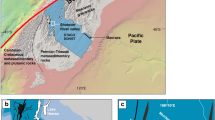Abstract
The Late Archaean Bronzewing lode-gold deposit is in the Yandal greenstone belt, Western Australia. It is located in a 500-m-wide, N–S trending, structural corridor consisting of an anastomosing set of brittle–ductile shear zones and is chiefly hosted by tholeiitic basalts, which are metamorphosed at mid- to upper-greenschist facies. Syn-peak metamorphic alteration surround all ore bodies, and alteration extends laterally for ≤80 m from individual mineralised structures. Individual alteration haloes partially overlap and form a >1.5-km-long and ≤300-m-wide domain. The alteration sequence, studied here at 140 m below the present undisturbed surface, comprises distal calcite–chlorite–albite–quartz, intermediate calcite–dolomite–chlorite–muscovite–albite–quartz and proximal ankerite–dolomite–muscovite–albite–quartz–pyrite zones. Mass transfer calculations indicate that chemical changes during alteration include enrichment of Ag, Au, Ba, Bi, CO2, K, Rb, S, Sb, Te and W, and depletion of Na, Sr and Y. The elements Al, Ca, Cr, Cu, Fe, Mg, Mn, Ni, P, Ti, V, Zn and Zr are immobile. The degree of chemical change increases with proximity to gold ore zones. In addition, abundant quartz veins indicate substantial silica mobility during the hydrothermal event, although there is no large relative silica loss or gain in the host rock. The broadest anomaly surrounding the Bronzewing gold deposit is defined by tellurium (>10 ppb) which, if it is a hydrothermal anomaly, extends beyond the 400 × 600 m study area. Anomalous values for CO2, K, Rb and Sb also define wider zones than does anomalous gold (>4 ppb), although even the lithogeochemical gold anomaly extends across strike for as much as 80 m away from ore and >600 m along the N–S strike of the shear zone corridor. Also carbonation and sericitisation indices outline large exploration targets at the Bronzewing deposit. Sericitisation indices define anomalies that extend for tens of metres beyond visible potassic alteration, whereas the anomalies defined by the carbonation indices do not extend beyond visible carbonation. None of the individual alteration indices or pathfinder elements are able to define consistent gradients towards ore. However, the respective dimensions of individual geochemical anomalies can be used as an extensive, although stepwise, vector towards ore. This sequence is, from species with broadest dispersion first, as follows: Te > CO2/Ca ≥ Sb, 3K/Al, Rb/Ti ≥ Au, W > Y/Ti (depletion) > Ag ≥ Bronzewing ore.
Similar content being viewed by others
Author information
Authors and Affiliations
Additional information
Received: 25 October 1999 / Accepted: 11 May 2000
Rights and permissions
About this article
Cite this article
Eilu, P., Mikucki, E. & Dugdale, A. Alteration zoning and primary geochemical dispersion at the Bronzewing lode-gold deposit, Western Australia. Mineral. Deposita 36, 13–31 (2001). https://doi.org/10.1007/s001260050283
Issue Date:
DOI: https://doi.org/10.1007/s001260050283




